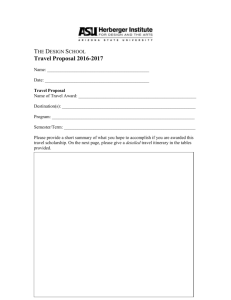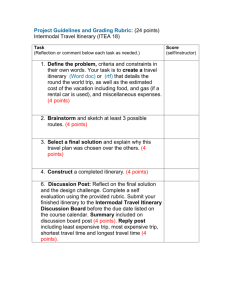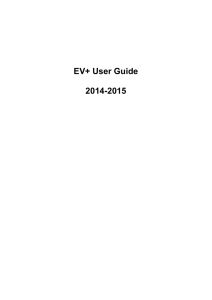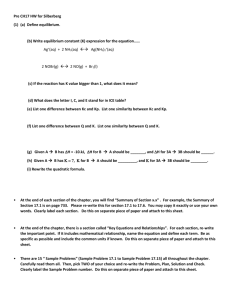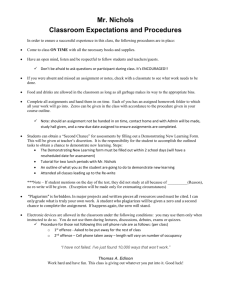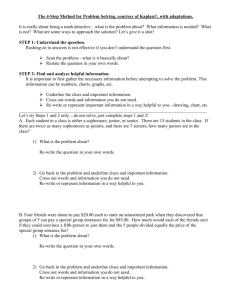Software Architecture Document
advertisement
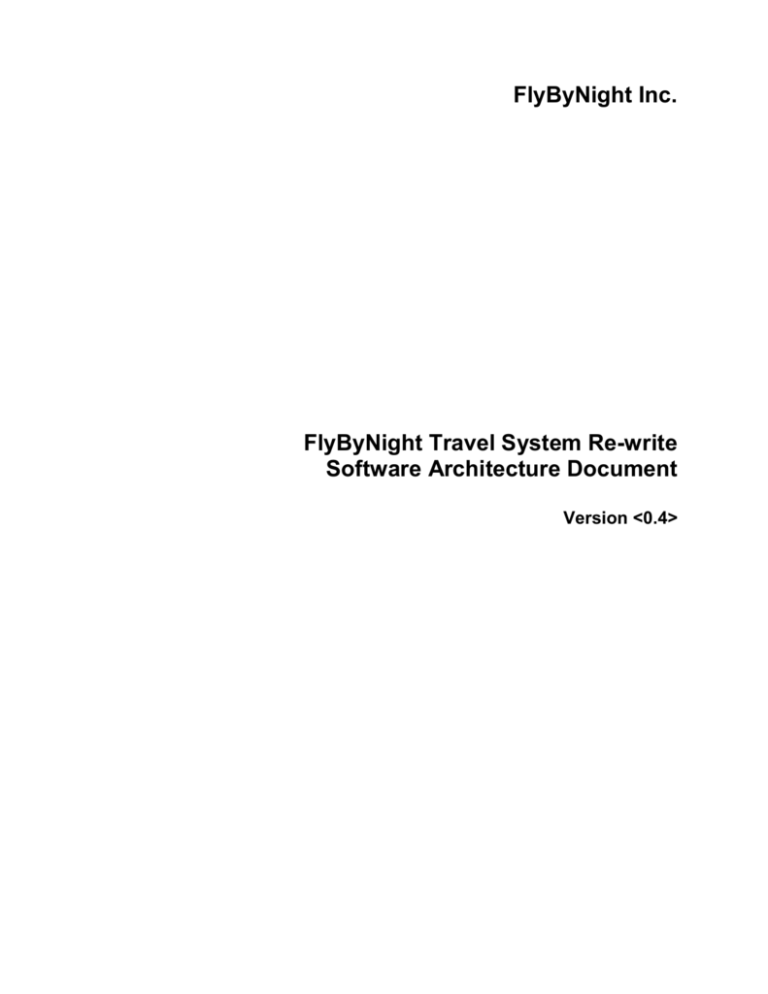
FlyByNight Inc. FlyByNight Travel System Re-write Software Architecture Document Version <0.4> FlyByNight Inc. Travel System Re-write Version: <0.4> Software Architecture Document Date: <3/3/2016> J:\USERS\MKANPA\TECH\ARCHITECT\FlyByNight Software Architecture.doc Revision History Date 11/04/02 Version 0.1 Description Created initial draft of the Architecture document. Author kanpa Documented Understanding of Nonfunctional requirements in section 3.4 11/22/02 0.2 Updated logical view - added class diagram kanpa Documented understanding of Business Architecture and Enterprise Architecture and the scope of our Reservation Application architecture based on J2EE in connection with the above two. Added reference to Semantic Analysis Pattern based Online Reservation System domain. 12/02/02 0.3 Updated Implementation view - added Component and Deployment Diagrams kanpa Added assumptions section 3.6. 01/02/03 Confidential 0.4 Updated Use-case view - added Sequence Diagrams and descriptions FlyByNight Inc., 2002 kanpa Page 2 of 25 FlyByNight Inc. Travel System Re-write Version: <0.4> Software Architecture Document Date: <3/3/2016> J:\USERS\MKANPA\TECH\ARCHITECT\FlyByNight Software Architecture.doc Table of Contents 1. 2. Introduction 5 1.1 1.2 1.3 Purpose Scope Definitions, Acronyms and Abbreviations 1.3.1 Java 2 Platform, Enterprise Edition Glossary, http://java.sun.com/j2ee/glossary.html 1.3.2 Travel Industry Dictionary, http://www.hometravelagency.com/dictionary/index.html 1.3.3 Architecture Characteristics 1.4 References 1.4.1 SCEA Project assignment deliverable, index.html 1.4.2 FBN Business Domain Model, Business Domain Model.html 1.4.3 FBN Use-Case Model, Use Case Diagram.html 1.4.4 Interview with FBN CEO and CIO, instructions.html 1.4.5 Core J2EE Pattern Catalog 1.4.6 Java Blue Prints Enterprise Guidelines 1.4.7 EAI Architecture Patterns 1.4.8 Patterns for e-business 1.4.9 Applying Traditional Design Patterns to EJB Applications 1.4.10 Building Java Technology based business frameworks 1.4.11 Pattern – Oriented Software Architecture, Frank Buschmann et el., 1.4.12 An Object Oriented Analysis Model for Flight Reservations 1.5 Overview 5 5 5 5 5 5 6 6 6 6 6 6 6 6 6 6 6 6 6 6 Architectural Goals and Constraints 7 2.1 2.2 2.3 2.4 2.5 2.6 2.7 Business Architecture Enterprise Architecture Non functional requirements 2.3.1 Technology requirements 2.3.2 Security requirements 2.3.3 Integration requirements 2.3.4 Performance requirements 2.3.5 Scalability requirements 2.3.6 Transaction requirements 2.3.7 UI requirements 2.3.8 Deployment requirements Assumptions 2.4.1 Object Management Policy 2.4.2 Reuse Management 2.4.3 Technical team expertise 2.4.4 Budget 2.4.5 Miscellaneous technical assumptions Constraints Objectives Software requirements 2.7.1 Operating System 2.7.2 Java Virtual Machine 2.7.3 J2EE Compliant Application Server 2.7.4 Web Server 2.7.5 Database Server 2.7.6 Email Server Confidential FlyByNight Inc., 2002 7 8 8 8 8 9 9 9 9 9 9 9 9 10 10 10 10 10 10 10 10 10 10 11 11 11 Page 3 of 25 FlyByNight Inc. Travel System Re-write Version: <0.4> Software Architecture Document Date: <3/3/2016> J:\USERS\MKANPA\TECH\ARCHITECT\FlyByNight Software Architecture.doc 3. 4. Use-Case View 11 3.1 11 12 13 14 15 16 17 18 Use-Case Realizations 3.1.1 Generic interaction model 3.1.2 Prepare Itinerary 3.1.3 Change Itinerary 3.1.4 Price Itinerary 3.1.5 Pay for Itinerary 3.1.6 Pay for Itinerary – Customer Selects Award Travel 3.1.7 Notify Frequent Flyer System Logical View 18 4.1 4.2 4.3 18 19 20 20 21 21 Overview Architecture analysis and design mechanisms Architecturally Significant Design Packages 4.3.1 Architectural Layers 4.3.2 Architectural Patterns 4.3.3 Design Patterns 5. Deployment View 22 6. Implementation View 22 7. Quality 23 7.1 7.2 7.3 7.4 7.5 7.6 24 24 24 24 24 25 8. Modularity Re-usability Extensibility Performance Manageability Security Conclusion Confidential 25 FlyByNight Inc., 2002 Page 4 of 25 FlyByNight Inc. Travel System Re-write Version: <0.4> Software Architecture Document Date: <3/3/2016> J:\USERS\MKANPA\TECH\ARCHITECT\FlyByNight Software Architecture.doc Software Architecture Document 1. Introduction 1.1 Purpose This document provides a comprehensive architectural overview of the system, using a number of different architectural views to depict different aspects of the system. It is intended to capture and convey the significant architectural decisions, which have been made on the system. It is also intended that this software architecture document will be representative of a common high-level abstraction of the system that most of the system’s stakeholders can use as a basis for creating mutual understanding, forming consensus and communicating with each other. This software architecture document serves as a supporting documentation to assist examiners in evaluating the necessary artifacts (Class diagram, Component Diagram and Sequence Diagrams) submitted as part of the Sun Certified Enterprise Architect for Java 2 Platform, Enterprise Edition. 1.2 Scope This software architecture document applies to FlyByNight Travel System Re-write project. The scope of this document is limited to meeting the given functional requirements provided in the form of Use Cases and satisfying the non-functional requirements captured during an interview with CEO and CIO of FBN. The information captured from the interview is consolidated and documented in a separate section titled non-functional requirements. See section 2.4. Though the importance of business architecture is appreciated, the scope of this document is to capture information relevant to software architecture only. A recommendation to evolve the business architecture is briefly outlined in this document and the details shall be maintained separately using FlyByNight Business Architecture Document 1 This document will be baselined and kept under version control once reviewed and the documented assumptions are validated. Embracing on an iterative approach with an inherent assumption that no system ever built is complete, as the software architecture evolves, this document will be updated. It is expected that the audience of this document will have basic understanding of the online flight reservation problem domain, software engineering, UML modeling, and java language concepts. 1.3 Definitions, Acronyms and Abbreviations 1.3.1 Java 2 Platform, Enterprise Edition Glossary, http://java.sun.com/j2ee/glossary.html 1.3.2 Travel Industry Dictionary, http://www.hometravelagency.com/dictionary/index.html 1.3.3 Architecture Characteristics Modularity: Allows application functionality to be developed somewhat independently and localizes the impact of design and implementation changes Reusability: Leverages the domain knowledge and prior effort of experienced developers to avoid recreating and revalidating common solutions to recurring application requirements and software design challenges. Extensibility: Allows for the easy addition of new functionalities 1 As of this writing, it is assumed that a business architecture document for FlyByNight Travel System doesn’t exist. Confidential FlyByNight Inc., 2002 Page 5 of 25 FlyByNight Inc. Travel System Re-write Version: <0.4> Software Architecture Document Date: <3/3/2016> J:\USERS\MKANPA\TECH\ARCHITECT\FlyByNight Software Architecture.doc Portability: Allows applications to run on machines of different operating systems. Inversion of control: Allows the framework (rather than developers) to determine which set of applicationspecific methods to invoke in response to external events. Consistence: Proves essential to a large-scale application to keep multiple ways of viewing and manipulating the same data. Scalability: Improves the capability to increase functionality loads over time. 1.4 References 1.4.1 SCEA Project assignment deliverable, index.html 1.4.2 FBN Business Domain Model, Business Domain Model.html 1.4.3 FBN Use-Case Model, Use Case Diagram.html 1.4.4 Interview with FBN CEO and CIO, instructions.html 1.4.5 Core J2EE Pattern Catalog http://java.sun.com/blueprints/corej2eepatterns/Patterns/index.html 1.4.6 Java Blue Prints Enterprise Guidelines http://java.sun.com/blueprints/guidelines/designing_enterprise_applications_2e/index.html 1.4.7 EAI Architecture Patterns http://www.eaijournal.com/PDF/Lutz.pdf 1.4.8 Patterns for e-business http://www-106.ibm.com/developerworks/patterns/index.html 1.4.9 Applying Traditional Design Patterns to EJB Applications http://java.sun.com/javaone/javaone2001/pdfs/829.pdf 1.4.10 Building Java Technology based business frameworks http://servlet.java.sun.com/javaone/javaone2000/pdfs/TS-518.pdf 1.4.11 Pattern – Oriented Software Architecture, Frank Buschmann et el., 1.4.12 An Object Oriented Analysis Model for Flight Reservations http://www.cs.wcupa.edu/~zjiang/flight.doc 1.5 Overview This software architecture document is organized under following headings. Confidential Architectural Goals and Constraints Use-Case View Logical View Deployment View Implementation View Conclusion FlyByNight Inc., 2002 Page 6 of 25 FlyByNight Inc. Travel System Re-write Version: <0.4> Software Architecture Document Date: <3/3/2016> J:\USERS\MKANPA\TECH\ARCHITECT\FlyByNight Software Architecture.doc 2. Architectural Goals and Constraints Before we proceed with the architectural goals, it will be useful to document what we don’t intend to do here. For the purpose of Sun Certified Enterprise Architect project assignment, we do not intend to come up with a sophisticated business architecture or an enterprise architecture. Our goals are to define FBN Travel system architecture that will adequately meet the given functional as well as non-functional requirements. It is assumed that this travel system re-write project is the first attempt to adopt Object oriented development methodology and hence no reusable artifacts exist currently in FBN. It is believed that through iterative and incremental approach, as we gain better understanding of the over all business requirements, sophisticated enterprise architecture can be evolved. Hence, it is important that the current architecture is flexible and extensible. We briefly outline here to further clarify what we mean by business architecture or enterprise architecture. 2.1 Business Architecture This section is kept here as the business architecture has significant impact on the software architecture. To compare it in terms of the Object Management Group (OMG) Model Driven Architecture (MDA), the business architecture represents Platform Independent Model (PIM) while the software architecture represents Platform Specific Model (PSM). Though we are presented with a Business Object Model for the purpose of FBN Travel System rewrite, it is viewed as a simple and concise model defined adequate enough for the purpose of understanding the given Use Cases. The Use Cases themselves are not complete to sufficiently automate the real life Travel system business processes but detailed enough to start defining architecture (Architectural analysis). It is assumed that they will further be enhanced in future iterations. The key to building successful business architecture is through Business Modeling. Business modeling is the practice of abstracting and representing a business for better understanding and communication. An abstract model could represent many different businesses but is specific to none. Through successive refinements, the model is transformed into an accurate representation of a specific target business. Use of semantic analysis patterns is one good way to build such an abstraction and represent a given business. They emphasize the functional aspects of the application model. For example, from the given business object model and use-cases, we will consider (assume or elaborate) the following requirements for the flight reservation system. Customers make reservations for specific seats in specific flights. A flight is defined by a number and a date, and determines a route from an origin airport to a destination airport. Equipment (or plane) is assigned to flights. A route is a way followed by a flight from its origin airport to its destination airport. A route may have several flights that share the same origin and destination airports. A span is the way to get from a start airport to a termination airport using one flight. The start (or termination) airport is called origin (or destination) airport of this span. For each flight there are several connecting flights (different flights that leave from an intermediate stop closely after its arrival) A segment (reservation segment) is a portion of an itinerary representing a reservation to travel on an airline flight. Each segment includes origin, destination, flight information and seat information. An itinerary includes a one-way route or a two-way route (round-trip). By a round-trip itinerary, a passenger can go to an airport and come back using the same route. A passenger may use different route to come back from the destination to which he/she arrived. For each route, he/she needs a set of one-way itinerary. Such a round-trip is a special case of one-way trip where its source and destination are the same. Given the above requirements, we could apply such semantic analysis patterns as Travel Ticket pattern, Confidential FlyByNight Inc., 2002 Page 7 of 25 FlyByNight Inc. Travel System Re-write Version: <0.4> Software Architecture Document Date: <3/3/2016> J:\USERS\MKANPA\TECH\ARCHITECT\FlyByNight Software Architecture.doc Assignment pattern, Collection pattern, Connection pattern, Routing pattern, Role object pattern etc., For example, the assignment (Assignment pattern) of (reservation) segment to Seat, Flight and Span is same as assignment to Faculty, Student and Staff in a University department information system. Another example is that the Connection pattern is used to show connecting flights, connecting spans and connecting airports. This Connection pattern is similar to a type of relationship in a class; managers and employees. In order to stay focused on J2EE Architecture, herewith we just make recommendation and provide guidance to come up with a solid Business Architecture, but we do not intend to do the same here. It is planned that in the current iteration of flight reservation system development, we will focus on laying out the foundation for J2EE based application architecture. For more details on Semantic analysis patterns for the flight reservation domain, a reference model can be found from the references section (Refer 1.4.12). 2.2 Enterprise Architecture The Enterprise architecture lays out foundation for the entire IT infrastructure in an enterprise. It defines reusable assets that will be utilized by systems development across the enterprise. By its nature, it is important for these reusable assets to be at a high level of abstraction. These reusable assets could be combinations of guidelines, patterns, frameworks, and libraries. The following lists some examples of the frameworks, enterprise architecture could typically include: Error Facility, Config Facility, Log Facility, Audit Log Facility, Security Facility, Authentication Facility, Help Facility, and Email Facility etc., Note that besides the available Java APIs to code such functionality, the advantage of building frameworks on top of it (an additional layer) would be to provide a simplified façade interface for each of the mechanism and enforce consistency among team members in availing such common infrastructure facilities. Again, detailing each of the frameworks would require a separate class and sequence diagrams. Building such sophisticated enterprise architecture will have major impact on the project cost (time and resources). Also, it is not advisible to over-engineer before such requirements are identified and the cost is estimated. It may be possible that the organization’s object management policy would permit the use of open source frameworks. For the reasons stated above, we wouldn’t be making an attempt to detail the above listed framework components. We will limit the scope of the current iteration (refers to the SCEA project assignment) to define J2EE based application architecture to meet the given functional and non-functional requirements. 2.3 Non functional requirements This section lists the non-functional requirements gathered from various sources. The architecture should ensure that these requirements are met. 2.3.1 Technology requirements System must be built using J2EE technology. 2.3.2 Security requirements All communication between web client and the server must be secured using SSL. Confidential FlyByNight Inc., 2002 Page 8 of 25 FlyByNight Inc. Travel System Re-write Version: <0.4> Software Architecture Document Date: <3/3/2016> J:\USERS\MKANPA\TECH\ARCHITECT\FlyByNight Software Architecture.doc 2.3.3 Integration requirements Travel system should be integrated with Frequent Flyer legacy system and TransMaster credit card processing system. 2.3.3.1 Frequent Flyer implementation details Perl CGI HTML Oracle DB 2.3.3.2 TransMaster credit card processing system implementation details Currently supports COBOL interface Currently communication is via a secured socket across a dedicated line. The next release of the product will be web enabled. New release will have an interface that will use XML-RPC over HTTPS New release will eliminate the cost of dedicated line by using Internet to communicate. New Travel system should be designed for the new release of the TransMaster system. 2.3.4 Performance requirements Travel agents should have the fastest system possible. Response time should never exceed 5 seconds. Web users will use 28.8K modem. Web users response time can’t exceed 10 seconds more than 20% of the time. In other words 80% of the time, the system should not exceed 10 seconds response time. 2.3.5 Scalability requirements The current system facilitates 35 concurrent travel agents. In the new system initially it is anticipated that 20 travel agents and 200 web users will be using concurrently. The maximum of 600 concurrent web users are expected. 2.3.6 Transaction requirements Currently the number of airfares being booked is 20,000 per day and it is expected to grow 10 times (around 200,000) within the first month of going national. 2.3.7 UI requirements Travel Agent UI will have to be the Java Application Client while web users UI will have to be Web client. 2.3.8 Deployment requirements The following hardware will be used for deployment. Software Component Application Server Oracle DB Server Web Servers Frequent Flyer system Hardware Sun E10000 Server Sun E6500 Server 2 450s E5500 2.4 Assumptions It is important to define an architecture that will match organization's culture and expectations. From that perspective it is necessary to understand about the organization's object management policy, Reuse management, current development standards, team expertise, budget etc., Herewith we list the assumptions made on these aspects. 2.4.1 Object Management Policy It is not clear if the FBN organization’s object management policy would allow the use of open source frameworks. Hence none of the open source framework is used in the current iteration of the architecture, though a recommendation will be made to consider such frameworks. Confidential FlyByNight Inc., 2002 Page 9 of 25 FlyByNight Inc. Travel System Re-write Version: <0.4> Software Architecture Document Date: <3/3/2016> J:\USERS\MKANPA\TECH\ARCHITECT\FlyByNight Software Architecture.doc 2.4.2 Reuse Management It is derived assumption that Travel System re-write is FBN’s first development project based on the Object oriented methodology. 2.4.3 Technical team expertise As it is FBN’s first object oriented development project and also as there is a design constraint that the system must be built using J2EE, it is assumed that the organization will either hire skilled resources or train existing resources in object oriented methodology, Java and J2EE technologies. 2.4.4 Budget We have made an implicit assumption that sufficient budget is available. 2.4.5 Miscellaneous technical assumptions 2.4.5.1 Persistence A confirmed decision is not made for the relational database server selection. It could be Oracle, Sybase or Informix, which will replace the IMS database. There is an E6500 server to host the Oracle database, which is assumed to be the one used by Frequent Flyer system. 2.4.5.2 Java application client deployment requirements There is no mentioning about the client deployment requirements as well as client desktop requirements. A recommendation will be made to utilize Java Web Start Architecture to deploy Java client application because of its ease of use in distributing client application bundles and automatic version checking and update features. 2.4.5.3 Authentication and User data store The choice of user data store implementation mechanism is not identified. The user data store can either be implemented using RDBMS or LDAP compliant directory Server. Most J2EE servers support integration with both implementation mechanisms to authenticate users. In order to achieve good return on investments made in relational database server and to keep expenses lower, initial rollover could be made using RDBMS. But based on the expected number of airfares booking which are 200,000 per day in the first month of going national, the total number of users are anticipated to be in a higher range over a year period and if user lookup (authentication) appears to be a bottleneck, it is recommended to migrate to LDAP compliant directory server as these servers are optimized for read or lookup operations. 2.5 Constraints Business analyst is no longer available. 2.6 Objectives The evolving component technologies and standards make it possible for the businesses to open up doors to interact effectively within the organization (EAI), with external business entities involved in the workflow (B2B), or to reach customers over the Internet (B2C). The nature of FBN business demands to adopt these component technologies in order to improve its business process and compete in the market to remain the leader in its business domain. 2.7 Software requirements 2.7.1 Operating System 2.7.2 Java Virtual Machine 2.7.3 J2EE Compliant Application Server J2EE compliant application server provides the infrastructure services necessary to build and deploy enterprise systems such as load balancing, clustering, object pooling, connection pooling, caching, persistence services, transaction management, security management, session management etc., The J2EE compliant application server plays vital role in FBN architecture to meet many of its non-functional Confidential FlyByNight Inc., 2002 Page 10 of 25 FlyByNight Inc. Travel System Re-write Version: <0.4> Software Architecture Document Date: <3/3/2016> J:\USERS\MKANPA\TECH\ARCHITECT\FlyByNight Software Architecture.doc requirements. Most importantly the above listed infrastructure services help in improving system performance and scalability. 2.7.4 Web Server 2.7.5 Database Server 2.7.6 Email Server 3. Use-Case View In this section, we will list and detail the use-case realizations for the purpose of Architecture illustration. Currently (Architectural design), only alternate flows that has architecture significance is illustrated using sequence diagrams. It is assumed that later during detailed design, the designer will complete the model for all flows, as necessary. 1. Generic interaction model Illustrates a typical sequence of interactions between significant classes to process user request. 2. Prepare Itinerary To illustrate how presentation tier components are interacting each other to handle view management and view navigation. 3. Change Itinerary To illustrate how business tier components interact together to service client requests. 4. View Mileage Account To illustrate how synchronous architecture is applied to communicate and retrieve data from another enterprise application. 5. Notify Frequent Flyer System To illustrate how asynchronous architecture is applied to notify business events to another enterprise application. 6. Pay for Itinerary To illustrate how B2B architecture is applied to communicate with credit services. 3.1 Use-Case Realizations This section illustrates how the software actually works by giving a few selected use-case (or scenario) realizations, and explains how the various design model elements contribute to their functionality. Confidential FlyByNight Inc., 2002 Page 11 of 25 FlyByNight Inc. Travel System Re-write Version: <0.4> Software Architecture Document Date: <3/3/2016> J:\USERS\MKANPA\TECH\ARCHITECT\FlyByNight Software Architecture.doc 3.1.1 Generic interaction model 3.1.1.1 Diagram Figure 1:Generic interaction model (Zoom at 350%) 3.1.1.2 Description The above sequence diagram shows generic sequence of interactions between key classes in order to process user request. For subsequent sequence diagrams, the following assumption are made in order to avoid cluttering the diagram and focus on the specific importance of the functionality. Assumption: The sequence diagrams shown here depict interaction between architecturally significant classes. It is assumed that in later iterations the use-cases will be detailed with necessary business rules and during the detailed design the designers will elaborate and model more detailed sequence diagrams. Confidential FlyByNight Inc., 2002 Page 12 of 25 FlyByNight Inc. Travel System Re-write Version: <0.4> Software Architecture Document Date: <3/3/2016> J:\USERS\MKANPA\TECH\ARCHITECT\FlyByNight Software Architecture.doc 3.1.2 Prepare Itinerary 3.1.2.1 Diagram Figure 2: Prepare Itinerary (Zoom at 450%) 3.1.2.2 Description The above sequence diagram for Prepare Itinerary illustrates how presentation tier components are interacting each other to handle view management and view navigation. When the container initializes the front controller servlet, a Command Dispatcher is instantiated during which display commands are constructed and action code to display command mapping is maintained. JSP View strategy is chosen to implement view pages. A view page forwards user requests to front controller Servlet Front strategy is chosen to implement Front controller The Front controller works with a Command Dispatcher to complete view management and navigation. Command Dispatcher and associated Display commands demonstrate the use of Service-to-Worker pattern as described in the J2EE patterns catalog. Display Commands gather data required by the view, decides the next view page to be rendered to the user and returns the next view name The Command Dispatcher forward to the next view. Confidential FlyByNight Inc., 2002 Page 13 of 25 FlyByNight Inc. Travel System Re-write Version: <0.4> Software Architecture Document Date: <3/3/2016> J:\USERS\MKANPA\TECH\ARCHITECT\FlyByNight Software Architecture.doc 3.1.3 Change Itinerary 3.1.3.1 Diagram Figure 3: Change Itinerary (Zoom at 400%) 3.1.3.2 Description The above sequence diagram for Change Itinerary illustrates how business tier components interact together To Whom It May Concern: service client requests. Both client tier and presentation tier classes re-use the business tier logic. In order to reduce coupling and hide the underlying implementation details of the business service, OnlineReservationDelegate is used. It follows the Business Delegate pattern as described in the J2EE Patterns Catalog. From Client tier, the View Handler (Mediator) classes will use the OnlineReservationDelegate class. From Presentation tier, the Display Command (Helper) classes will use the OnlineReservationDelegate class. The OnlineReservationDelegate intercept service level exceptions and generate user-friendlier application level exceptions. The OnlineReservationDelegate uses ServiceLocator (application of Service Locator pattern as described in the J2EE Patterns Catalog) to hide the details of business service lookup code. The ServiceLocator will improve performance by providing Caching Facility. The OnlineReservationDelegate will then invoke services on OnlineReservationFacade, which applies the Session Facade pattern as described in J2EE Patterns catalog. The OnlineReservationFacade is implemented using Stateless Session Façade strategy. Business object as Session Bean strategy is used to provide business service and wrap Data access logic. Confidential FlyByNight Inc., 2002 Page 14 of 25 FlyByNight Inc. Travel System Re-write Version: <0.4> Software Architecture Document Date: <3/3/2016> J:\USERS\MKANPA\TECH\ARCHITECT\FlyByNight Software Architecture.doc For example Online Reservation Façade will interact with such classes as ItineraryController, FlightSelectionController, CustomerController etc., 3.1.4 Price Itinerary 3.1.4.1 Diagram Figure 4: Price Itinerary (Zoom at 500%) 3.1.4.2 Description This sequence diagram illustrates The use of Pricing strategy class to calculate the price of an itinerary Confidential FlyByNight Inc., 2002 Page 15 of 25 FlyByNight Inc. Travel System Re-write Version: <0.4> Software Architecture Document Date: <3/3/2016> J:\USERS\MKANPA\TECH\ARCHITECT\FlyByNight Software Architecture.doc The assumption made that the system shall allow the actor to save an itinerary once it is priced and the price is verified. The saved itineraries can later be paid. The seat assignment logic. When new itinerary is saved, the seats for each of the reservation segment is assigned. When a changed itinerary is saved, the seats for each new reservation segment is assigned, while the seats for each replaced segment is unassigned. Assigned seats not necessarily mean confirmed seats, I t is only upon payment of the itinerary the seats will be reserved (or occupied) by the passenger. 3.1.5 Pay for Itinerary 3.1.5.1 Diagram Figure 5: Pay for Itinerary 3.1.5.2 Description The above sequence diagram Pay for Itinerary illustrates how B2B architecture is applied to communicate with credit services. Upon receiving request to pay for itinerary, the ItineraryController checks if the itinerary is new or modified, if so saves the itinerary. (For save operation, check the sequence described in the Price Itinerary sequence diagram after Pricing the itinerary) It then gets an implementation of ICreditCardServices,, which is TransMasterServices and issue request to authorize credit card. The TransMasterServices uses Integration Adapter pattern (See References section for link to EAI Architectural patterns) The TransMasterServices creates AuthorizeTxMessage class. The AuthorizeTxMessage converts the CreditCardVO into B2BEvent and vice versa. The B2BEvent class encapsulates the RPC-XML message format. The B2BEvent is now sent using HTTPSAdapter (protocol handler) to the TransMaster system. Upon receiving the response (pseudo-synchronous request/reply interaction model), it validates if the credit card is authorized. A PaymentAckMessage will be used to convert the RPC-XML response to the Confidential FlyByNight Inc., 2002 Page 16 of 25 FlyByNight Inc. Travel System Re-write Version: <0.4> Software Architecture Document Date: <3/3/2016> J:\USERS\MKANPA\TECH\ARCHITECT\FlyByNight Software Architecture.doc PmtAckVO If authorized, it marks the itinerary as paid and confirm seats for all the reservation segments for that itinerary. An email notification is sent either on successful or unsuccessful authorization of credit card. 3.1.6 Pay for Itinerary – Customer Selects Award Travel 3.1.6.1 Diagram Figure 6: Pay for Itinerary: Customer Selects Award Travel 3.1.6.2 Description The above sequence diagram illustrates the EAI architecture used as part of the alternate flow ‘Customer Selects Award Travel’ in the Pay for Itinerary use-case. For EAI, the façade uses FrequentFlyerServices integration adapter to retrieve customer’s mileage account information from frequent flyer system. Confidential FlyByNight Inc., 2002 Page 17 of 25 FlyByNight Inc. Travel System Re-write Version: <0.4> Software Architecture Document Date: <3/3/2016> J:\USERS\MKANPA\TECH\ARCHITECT\FlyByNight Software Architecture.doc 3.1.7 Notify Frequent Flyer System 3.1.7.1 Diagram Figure 7: Notify Frequent Flyer system 3.1.7.2 Description The above sequence diagram illustrates the EAI approach using asynchronous fire and forget update style pattern. The ReservationEvent, which is an EAIEvent is instantiated The Reservation Event is published to JMS Queue Asynchronously, the ReservationEventListener, a Message Driven Bean, is notified of this event. The handling of this event is delegated to ReservationEventHandler. Based on the event code, it uses MileageAccountDAO to update the account. 4. Logical View 4.1 Overview This subsection describes the overall decomposition of the design model in terms of layers. Confidential FlyByNight Inc., 2002 Page 18 of 25 FlyByNight Inc. Travel System Re-write Version: <0.4> Software Architecture Document Date: <3/3/2016> J:\USERS\MKANPA\TECH\ARCHITECT\FlyByNight Software Architecture.doc Figure 8: Class diagram showing key participating classes in the FBN architecture (Zoom at 400%) 4.2 Architecture analysis and design mechanisms By doing Architectural Analysis, Architectural Design from the given requirements, the following analysis mechanisms and design mechanisms are identified. Analysis Mechanism GUI application client GUI application client deployment Web client application Workflow process logic Integration/ Messaging E-Mail Service Connection Pooling Persistence Transaction management Secure Server systems Transport Security Authentication, Authorization Confidential Design Mechanism Java Swing APIs Java Web Start Architecture. JSP, Servlets, HTML, Javascript EJB Session Bean J2EE container's JMS Provider will be utilized. Messaging will be accomplished using JMS APIs and Message Driven Beans. JavaMail API will be used to send e-mail notification J2EE container's connection pool feature will be utilized. RDBMS data store will be used. Access to RDBMS will be done using JDBC API. J2EE container's transaction services will be utilized. The DMZ (Demiliterized Zone) configuration will be setup. Will be accomplished using SSL enabled server RDBMS realm will be created to define users and groups FlyByNight Inc., 2002 Page 19 of 25 FlyByNight Inc. Travel System Re-write Version: <0.4> Software Architecture Document Date: <3/3/2016> J:\USERS\MKANPA\TECH\ARCHITECT\FlyByNight Software Architecture.doc Authentication via GUI application client Caching Scalability J2EE container will be utilized to delegate the authentication service request. Roles will be defined in web, ejb deployment descriptors. Login view page will be defined in web deployment descriptor. Security constraints will be defined in web, ejb deployment descriptors. JAAS Framework. A JAAS based authentication module will be implemented to authenticate users. Custom Caching Facility to cache flight search results and improve performance. J2EE container's clustering, load balancing capabilities will be utilized. Also having session beans to implement workflow proessing and using container's object pooling features will help to improve scalability. 4.3 Architecturally Significant Design Packages 4.3.1 Architectural Layers2 This architectural pattern describes a proven approach to structuring software. This pattern promotes development of software that is easy to extend and maintain. Tier Client Tier Presentation Tier Business Tier Integration Tier List of Classes shown in the class diagram UI Application, View Handler, View. The concrete view handlers and view components are omitted in the class diagram intentionally for the purpose of brevity. OnlineReservationServlet, CommandDispatcher, DisplayCommand. The concrete Display commands and JSPs are omitted in the class diagram intentionally for the purpose of brevity. OnlineReservationDelegate, OnlineReservationFacade, ItineraryController, CustomerController, FlightSelectionController, Flight, Itinerary, Customer DAOs, Profile, CreditCard, Payment, Route, Span, Segment, Equipment, Seat. The value objects are not shown in the class diagram in order to avoid cluttering. TransMasterServices, FrequentFlyerServices, ReservationEventListener, MileageAccountDAO, EAIEvent, B2BEvent 4.3.1.1 The Client Layer This layer is responsible to represent all types of clients accessing the system or application. A client can be a web browser, a Java or other application, a Java Applet, a WAP phone, a network application, or any other pervasive devices. 4.3.1.2 The Presentation Layer The Presentation Layer encapsulates the presentation logic required to service the clients that access the system. 2 Busch Mann et al. Confidential FlyByNight Inc., 2002 Page 20 of 25 FlyByNight Inc. Travel System Re-write Version: <0.4> Software Architecture Document Date: <3/3/2016> J:\USERS\MKANPA\TECH\ARCHITECT\FlyByNight Software Architecture.doc This layer will contain the web components such as Servlets and JSPs. 4.3.1.3 The Business Layer This layer contains the business data and business logic. All business processing for the application is centralized into this layer. 4.3.1.4 The Integration Layer This layer is responsible for communicating with external resources and systems such as data stores and legacy applications. The business objects in the Business Layer will access data or services that reside in the Resource Layer using the components in this layer. The components in this layer can use JDBC, J2EE Connector technology, or some proprietary middleware to work with the Resource Layer. 4.3.2 Architectural Patterns Architecture comprises frameworks, patterns, standards, guidelines, and libraries. Hence, in this section we will document the architectural patterns used to build FBN travel system. 4.3.2.1 Layered Architecture Layered architecture refers to partitioning the system into a number of layers by placing them on top of one another such that services of layer n+1 consist mostly of the services provided by layer n or a combination of sub layers. Within the same layer, all components work at the same level of abstraction or the same functionality. 4.3.2.2 MVC Architecture MVC stands for Model-View-Controller. The responsibilities of each are described below. Model Encapsulates application state Notifies view of state changes Responds to state queries Generates B2B events View Forwards user requests to control Allows control to choose next view Query application state Renders GUI Control One for each functionality Updates application model Determines next view Defines B2C application behavior 4.3.3 Design Patterns The current iteration of FBN architecture uses the following design patterns. These patterns help to verify and validate if the defined architecture meet the given non-functional requirements. Please refer to 1.4.5 in the References section, the Core J2EE Patterns for details on each of the pattern listed below. In future iterations, a separate Design guidelines document will be compiled to include information on how the use of these patterns help to meet the quality attributes of defined architecture such as modularity, re-usability, extensibility, interoperability, consistency, Front Controller View Helper Service-to-Worker Confidential FlyByNight Inc., 2002 Page 21 of 25 FlyByNight Inc. Travel System Re-write Version: <0.4> Software Architecture Document Date: <3/3/2016> J:\USERS\MKANPA\TECH\ARCHITECT\FlyByNight Software Architecture.doc Business Delegate Service Locator Command Controller Coarse Grained Entity Value object Integration Adapter DAO Factory Method 5. Deployment View The following diagram shows a proposed deployment model for the FBN travel system. The nodes such as Firewalls, Load balancer, proxy server(s) are assumed to be currently existing.. This deployment model utilizes the DMZ setup to protect system from potential attackers. The web clients (Internet users) will use HTTPS protocol and the application clients (Intranet users) will use RMI-IIOP protocol to communicate with FBN travel system. Figure 9: FBN Travel System Deployment model (Zoom to 200%) 6. Implementation View This section describes the overall structure of the implementation model, the decomposition of the software into layers and subsystems in the implementation model, and any architecturally significant components. Confidential FlyByNight Inc., 2002 Page 22 of 25 FlyByNight Inc. Travel System Re-write Version: <0.4> Software Architecture Document Date: <3/3/2016> J:\USERS\MKANPA\TECH\ARCHITECT\FlyByNight Software Architecture.doc Figure 10: FBN Travel System Component Diagram 7. Quality In this section, we will validate how the use of selected patterns for the FBN architecture helps to meet the various quality attributes associated with the architecture. Only select examples are listed here, documentation on complete architecture validation is beyond the scope of this document. Confidential FlyByNight Inc., 2002 Page 23 of 25 FlyByNight Inc. Travel System Re-write Version: <0.4> Software Architecture Document Date: <3/3/2016> J:\USERS\MKANPA\TECH\ARCHITECT\FlyByNight Software Architecture.doc 7.1 Modularity Allows application functionality to be developed somewhat independently and localizes the impact of design and implementation changes The use of Service-to-worker and View Helper patterns improves modularity or provides improved role separation by separating the formatting logic from the application business logic and reduces dependencies on the same resources among individuals fulfilling different roles. 7.2 Re-usability Leverages the domain knowledge and prior effort of experienced developers to avoid recreating and revalidating common solutions to recurring application requirements and software design challenges. The use of Front Controller improves reusability by promoting cleaner application partitioning. Code that is common among components is moved into the front controller and reused for each request. With the use of Display Command (View Helper) pattern, business logic that is factored out of JSP into commands may be reused across numerous JSPs. The code is not duplicated in many different JSPs, and thus is easier to maintain and debug. 7.3 Extensibility Allows for the easy addition of new functionalities. For example, when new presentation tier functionality is required we can quickly create a new display command, appropriate JSP view page and easily plug-in by registering it with the Command Dispatcher without much impact to the existing functionality. 7.4 Performance Performance can be measured in terms of response time for a given screen transaction per user or in transaction throughput, which is the number of transactions in a given time period, usually one second. Though performance can be improved at various levels such as operating system, network, java virtual machine, application server etc., in this section we will list how the use of selected design patterns for FBN architecture could contribute to performance improvements. The use of business delegate provides caching services (and better performance) to the presentation tier for common service requests. The use of Session Façade improves performance by reducing network overhead between the client and the server because all interactions are routed via the Session Façade in a coarse grained manner. The use of Value Object pattern improves performance by transferring the values from the business tier to the client/presentation in one remote method call. The value object acts as a data carrier and reduces the number of remote network methods calls required to obtain the attribute values. The Service Locator can cache the initial context objects and references to the factory objects to eliminate unnecessary JNDI activity that occurs when obtaining the initial context and the other objects. This improves the application performance. 7.5 Manageability Manageability is the ability to manage the system to ensure the continued health of a system with respect to scalability, reliability, availability, performance and security. The use of business delegate pattern reduces coupling between the presentation tier and business tier by hiding all the business tier implementation details. It is easier to manage changes because they are centralized in one place. The use of Session Façade decouples the underlying business objects and system from clients, thus reducing the tight coupling between the two tiers and the client’s dependency on the business objects. Inter business objects are abstracted into a workflow in a façade. This provides better manageability, greater flexibility to cope with changes. Because all data access operations are delegated to the data access object, the separate data access layer can Confidential FlyByNight Inc., 2002 Page 24 of 25 FlyByNight Inc. Travel System Re-write Version: <0.4> Software Architecture Document Date: <3/3/2016> J:\USERS\MKANPA\TECH\ARCHITECT\FlyByNight Software Architecture.doc be viewed as the layer that can isolate the rest of the application from data access implementation. This centralization makes the application easier to maintain and manage. 7.6 Security Security is the ability to ensure that the system can’t be compromised. Security includes not only issues of confidentiality and integrity, but also relates to Denial-of-Service (Dos) attacks that impact availability. The FBN travel system deployment will utilize the DMZ setup to protect from potential attackers. In order to utilize the J2EE Container's authentication and authorization services, a RDBMS realm will be created in which the users and groups are defined. As per the pre-conditions stated in the use-cases, any view pages participating in the use-cases Change Itinerary, Price Itinerary, Pay for Itinerary will be configured as a ‘protected resource’ in web deployment descriptor. A login view page (JSP) and authentication error page (JSP) will be created and configured using web deployment descriptor. Whenever a protected resource is accessed, if the user is not logged in, it will present the configured login view page to the user. Two roles will be defined for the actors ‘Travel Agent’ and ‘Customer’. All customer interaction will be secured using SSL and accessing the application URL using HTTP protocol will be prevented. As shown in the use-case model diagram, users belonging to both travel agent and customer roles will be permitted to access all of the business functionality. Access to web resources will be granted to Customer role (using web deployment descriptor) and access to EJB resources will be granted to both Customer and Travel Agent roles (using EJB deployment descriptor – declarative security). In addition to declarative security, we will require programmatic security to allow users belonging to travel agent be able to access any customer’s reservation, while users belonging to customer role can only access their own profile and itineraries. The application client (client tier) during its startup will register itself with Security Facility 3 framework. This Security Facility checks to see if it is protected application and if so check if the user is authenticated to use this application. If not authenticated, the Authentication Facility framework will be used to authenticate the user using JAAS based implementation of authentication module. 8. Conclusion The document defined the FBN architecture to meet given requirements for Sun Certified Enterprise Architect project assignment. More importantly as the architecture is defined using best software engineering practices with the use of architectural patterns and design patterns, it can be easily understood and validated. The architecture is represented using use-case view, logical view, deployment view and implementation view to show how the defined architecture is used to realize (or design/implement) the given functional requirements. 3 For the purpose of brevity, the Security Facility and Authentication Facility framework is mentioned, but not detailed in this document. Confidential FlyByNight Inc., 2002 Page 25 of 25
